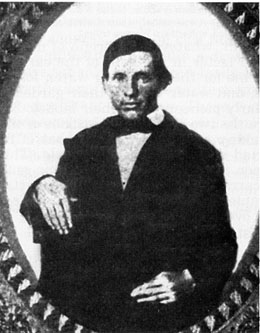During the summer of 1850, John Cornelius Holgate (1828-1868) canoes up Puget Sound from the village of Olympia. He explores the Duwamish River, and considers settling on the site (the future Georgetown) claimed the following year by King County's first non-Native settlers -- Luther M. Collins (1813-1862), Henry Van Asselt (1817-1902), Jacob Maple (or Mapel) (1798-1884), and Samuel Maple (1827-1880). Historian Edmond Meany (writing in 1909) and others following him (such as Murray Morgan in Skid Road) incorrectly give the honor of "the first settler of Seattle" to Holgate, writing that he selected land but neglected to register his claim. The notion that Holgate might have or should have registered a claim that he supposedly selected is highly improbable. The Donation Land Claims Act passed by the U.S. Congress did not take effect until September 27, 1850, and given the slow pace of communications (news traveled by foot or boat), it is unlikely that Holgate even knew about it. The second reason it is doubtful that Holgate made a land claim (but failed to register it) is that, except for Native American guides, he was probably traveling alone. The first white settlers to the Pacific Northwest settled in small groups which provided mutual support and protection. Holgate, a bachelor, wrote to family members in Iowa that he wished to find a wife.
John Holgate's Story
In 1847, at the age of 18, Holgate traveled west from Iowa on the Oregon Trail with a party of Quakers. Not knowing the flora of the Northwest, he carried a fir sapling from the Midwest with the idea of transplanting it and starting a forest. Holgate arrived at Oregon Territory on August 9, 1847. He was very much surprised to find that his fir sapling was redundant and entirely worthless (Seattle Weekly Chronicle, 1883).
He served in the Oregon Volunteers during the 1847-1848 Cayuse war. Toward the end of the war he became seriously ill with measles. An officer of the Hudson's Bay Company told him that Puget Sound country was best for health (Grant, 88). In the summer of 1850, at the age of 21 (Holgate was born on October 15, 1828), he explored the Duwamish River and considered settling on the site where Collins and Mapel homesteaded the following year. [Note: Historian Clarence Bagley, in Pioneer Seattle and its Founders misdates Holgate's exploration of the Duwamish as taking place in 1849.]
Holgate wrote to a family member of his six-week (mid-August to early October 1850) exploration of Puget Sound, "The Sound has four rivers along its eastern shore. The valleys of these rivers will average about 15 miles in width and are about equally divided in prairie and timber." He declared the Sound to be "decidedly ahead of any other country" he had ever seen. But he did not stay, because "I have not got that other 'rib' yet" (Grant, 89).
He did not wish to settle by himself, and headed south in search of a wife. Some accounts state that he returned to the East to bring out his relatives, but it is likely that he remained in Oregon south of the Columbia River until 1853 (Hanford). In the spring of 1853, John Holgate returned to the Duwamish (still a bachelor) and on June 21, 1853, he staked a Donation Land Claim and resided east of the Duwamish River on Seattle's future Beacon Hill. At the time, the base of Beacon Hill approximated the shoreline of Elliott Bay.
The Holgate/Hanford Clan Arrives
John Holgate's sister, Abby (Holgate) Hanford (b. 1824) was married to Edward Hanford. The Hanfords came to Seattle in 1854 and selected a claim adjoining John Holgate's claim. The 1857 census of King County, Washington, listed John Holgate, his younger brother Lemuel Holgate, their mother Elizabeth Holgate, and the Hanfords. They were among the 152 persons of European descent living in King County at that time.
John Holgate was a gold prospector and it is likely that the considerable amount of time he spent away from his King County claim was devoted to prospecting for gold. Around 1863, he rushed to the Idaho Basin gold fields. By the spring of 1864 he was prospecting in the Owyhee region of southwest Idaho. In November 1867, the Golden Chariot mine on War Eagle Mountain near Silver City, Idaho, started shipping gold and silver ore in great quantities. This became one of the largest mines in Idaho. John Holgate owned about one-sixth interest in the Golden Chariot mine.
John Holgate's Death
In late February 1868, a boundary question arose between the Golden Chariot mine and the adjoining Ida Elmore mine. The dispute quickly escalated and the mine camps became armed fortresses. Underground, the two factions exchanged gunfire. All of Idaho Territory began to focus attention on the "War on the Mountain."
On March 25, 1868, Golden Chariot miners attempted to overpower the other side through one of the mine tunnels. The Owyhee Avalanche reported, "Desperate fighting ensued during the charge ... . John C. Holgate ... one of the foremost in the advance, was shot in the head, and must have died instantaneously." The battle did not end until, at the request of the Idaho governor, United States Army troops arrived to patrol the camps on April 5, 1868.
John Holgate's burial on March 26, 1868, in a nearby cemetery was attended by a large crowd. The original tombstone marks his grave.

